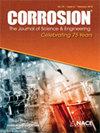Bipolar metal bridge for electrochemical tests in autoclave
IF 1.3
4区 材料科学
Q4 MATERIALS SCIENCE, MULTIDISCIPLINARY
引用次数: 0
Abstract
The core of any electrochemical measurement lies in the assessment of interfacial potentials. The reference electrode plays an imperative role in any electrochemical measurement. Most commercially available reference electrodes need to be separated from the solution using a porous frit or a Luggin-Haber probe/salt bridge; nonetheless, a certain degree of ionic flow remains necessary. Building upon prior research, this study delves into using an inert metal wire to bridge the reference electrode and the test solution in a physically distinct container. The impact of both physical and electrochemical variables on the efficacy of this metallic bridge was rigorously examined. Remarkably, linear correlations between potential and temperature and potential and pressure were established, while non-linear correlations were observed with the bridge's submerged area and the electrolyte's concentration. Empirical equations were deduced, facilitating the correction of these effects on measurements. Furthermore, the viability of the metallic bridge was assessed as a straightforward alternative for electrochemical potential measurements in challenging environments such as autoclaves and other harsh conditions.用于高压釜电化学测试的双极金属电桥
任何电化学测量的核心都在于评估界面电位。参比电极在任何电化学测量中都起着至关重要的作用。大多数市售参比电极需要使用多孔熔块或 Luggin-Haber 探针/盐桥与溶液分离;然而,一定程度的离子流仍然是必要的。在先前研究的基础上,本研究深入探讨了使用惰性金属丝将参比电极和测试溶液桥接在一个物理上不同的容器中。研究严格考察了物理和电化学变量对这种金属电桥功效的影响。值得注意的是,电位与温度、电位与压力之间建立了线性关系,而电桥的浸没面积和电解液浓度之间则存在非线性关系。推导出的经验方程有助于修正这些对测量的影响。此外,还对金属电桥的可行性进行了评估,认为它是在高压灭菌器等恶劣环境中进行电化学电位测量的直接替代方法。
本文章由计算机程序翻译,如有差异,请以英文原文为准。
求助全文
约1分钟内获得全文
求助全文
来源期刊

Corrosion
MATERIALS SCIENCE, MULTIDISCIPLINARY-METALLURGY & METALLURGICAL ENGINEERING
CiteScore
2.80
自引率
12.50%
发文量
97
审稿时长
3 months
期刊介绍:
CORROSION is the premier research journal featuring peer-reviewed technical articles from the world’s top researchers and provides a permanent record of progress in the science and technology of corrosion prevention and control. The scope of the journal includes the latest developments in areas of corrosion metallurgy, mechanisms, predictors, cracking (sulfide stress, stress corrosion, hydrogen-induced), passivation, and CO2 corrosion.
70+ years and over 7,100 peer-reviewed articles with advances in corrosion science and engineering have been published in CORROSION. The journal publishes seven article types – original articles, invited critical reviews, technical notes, corrosion communications fast-tracked for rapid publication, special research topic issues, research letters of yearly annual conference student poster sessions, and scientific investigations of field corrosion processes. CORROSION, the Journal of Science and Engineering, serves as an important communication platform for academics, researchers, technical libraries, and universities.
Articles considered for CORROSION should have significant permanent value and should accomplish at least one of the following objectives:
• Contribute awareness of corrosion phenomena,
• Advance understanding of fundamental process, and/or
• Further the knowledge of techniques and practices used to reduce corrosion.
 求助内容:
求助内容: 应助结果提醒方式:
应助结果提醒方式:


